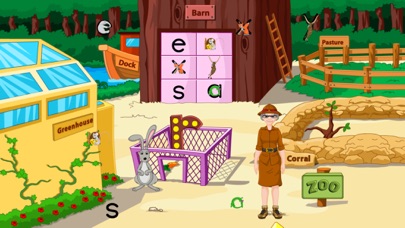
**GAME INTENDED FOR iPADS AND LARGE SCREEN PHONES**
There are six different places in the Petting Zoo: the Central Barnyard, the Bird House, the Horse Stable, the Pen, the Pond and the Reptile Exhibit. In each Zoo area, there are many games inside the games, giving children plenty of opportunities for children to play and learn.
In each area, there is a rectangular sign that contains the Animal Pictures, Merged Animal Letters and plain letters to match. You will also find matching Animal Pictures, Merged Animal Letters and plain letters scattered around the yards. Tell the child that as she or he finds one of them, she or he is to click on it and drag it to its match on the sign. The sign will turn a different color, showing that the child is correct. If it doesn’t, try another match. (The letter will snap back in position if incorrect.)
The child will know that there are still matches to make because the sign will not all be one color.
Zoophonia and Zeke Zebra will encourage your children after four correct matches. Zoophonia also Signals and sounds the letter after every match. Encourage your children to Signal and sound with her for alphabetic reinforcement.
If your child cannot find the other letters, remind them to click on Zoophonia. She’ll look around the barnyard and tell the child how many to locate. She’ll give a hint by Signaling and sounding the missing letter (Picture, Merged or plain).
When the game is over and the child has been successful, Robby Rabbit hops in and does something funny. Zeke appears and suggests the child go to another part of the barnyard for more fun!
To exit, click on the large letter ‘r’ in each scene to return to the main barnyard where all the Robby Rabbit Matching Pairs games can be found. Click on the Zoo Map to access the other games in the Zoo.
Lesson Objectives. The child will:
-Children will learn lowercase letter recognition (shapes, sounds, Alliterative Animal Names, and Body Signals)
-follow directions
-make decisions
-learn how to navigate and manipulate interactive elements on a screen using eye-hand coordination
-learn observation, critical thinking, and matching skills
About Zoo-phonics
Teach your students the alphabet in TWO WEEKS! Faster than you ever expected your students will be reading, spelling and writing!
The Zoo-phonics Multisensory Language Arts Program is a kinesthetic, multi-modal approach to learning all aspects of language arts, including vocabulary development and articulation, based on phonics and phonemic awareness.
The principle of Zoo-phonics maximizes understanding, memory, utilization and transference to all areas of the reading, spelling and writing process in a playful and concrete manner.
Zoo-phonics is a method developed to make children strong readers and spellers using a “phono” (hearing), “oral” (speaking), “visual” (seeing), “kinesthetic” (moving), and tactile (touching)—whole brain approach. Students actually learn the sounds of the alphabet and advanced phonemic concepts through an easily understood, concrete method of presentation.
Zoo-phonics uses animals drawn in the shapes of the letters for ease in memory. A related body movement is given for each letter. This concrete approach cements the sounds to the shapes of the letters. Lowercase letters and their sounds are taught first, capital letters and letter names are taught later.
Zoo-phonics also provides a springboard for all other academia such as math, art, music, cooking/nutrition, social studies, science, grooming, physical education and sensory/drama.
Every aspect of the program has been field-tested and found to be effective. Educational research repeatedly supports the focus of phonics in early reading programs, as well as the educational benefits of pictorial mnemonics and kinesthetic approaches to learning that are unique to Zoo-phonics.
Currently Zoo-phonics is used throughout the United States and internationally as a highly effective language arts program.



